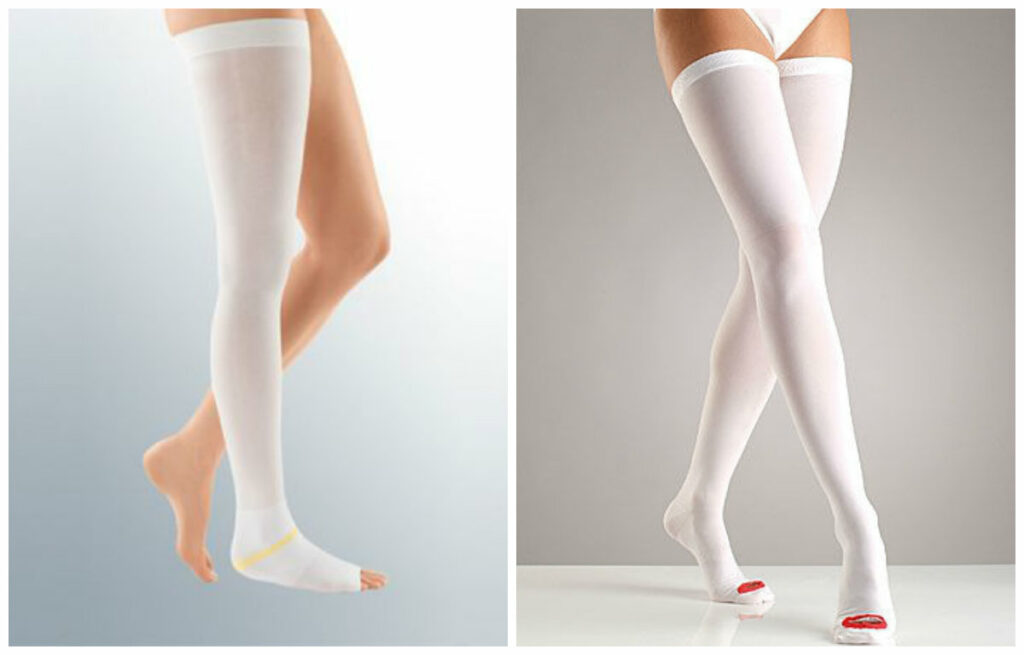Choosing compression stockings is not just a purchase, it is an important decision in terms of looking after your own health and wellbeing. Compression stockings are a medical device designed to maintain and improve blood circulation in the legs, which is especially important for people facing problems with venous return, swelling, leg fatigue or varicose veins. Using these products not only helps to reduce symptoms, but also helps to prevent the development of more serious vein diseases.
Modern lifestyle, which often includes long periods of sitting at a desk or standing for long periods of time, contributes to vein problems. In addition, risk factors include hereditary predisposition, pregnancy, overweight, and many others. In this context, compression stockings become not just a wardrobe item, but a means of preventing and supporting leg health.
Their unique structure, which provides different levels of pressure in specific areas of the leg, helps to optimise blood flow, relieves pressure on the venous valves and reduces the risk of blood clots. This makes them an indispensable tool not only for people suffering from venous diseases, but also for athletes, pregnant women, travellers, and anyone else who wants to take care of their health.
In addition to the medical indications for use, the modern market offers a wide range of compression stockings in different designs and colours, allowing you to integrate them into your everyday look without compromising on style. From classic black, beige to bright colours, patterns and different textures, everyone can choose the perfect option that combines both therapeutic and aesthetic aspects.
Let’s look at the key aspects that will help you make the right choice.
Determining the degree of compression
Determining the degree of compression of compression stockings is a critical step in the selection of stockings, as it directly affects not only the effectiveness of treatment and prevention of venous diseases, but also the comfort of wearing them. The degree of compression, measured in millimetres of mercury (mmHg), indicates the amount of pressure the stockings exert on the legs. Depending on individual needs and vein health, the appropriate degree of compression is selected.
Light compression (15-20 mmHg)
This category of compression stockings is designed for people who experience minor vein problems or wish to prevent them from occurring. Light compression is ideal for those who lead a largely sedentary or standing lifestyle, which often leads to leg fatigue, slight swelling and discomfort at the end of the day. It is recommended to wear these stockings:
- When travelling by plane or car for long periods of time, when you have to stay in one position for long periods of time.
- Office workers, teachers, salespeople and anyone who spends a lot of time on their feet or at a desk.
- For the prevention of venous diseases in persons with initial signs of impaired venous outflow or hereditary predisposition.
Medium compression (20-30 mmHg)
Medium compression is recommended for people with already identified vein problems such as varicose veins, chronic venous insufficiency, oedema. This level of compression helps:
- Reduce soreness and heaviness in the legs.
- Reduce the risk of blood clots and improve blood circulation.
- Speed up recovery after vein surgery and prevent recurrence of the disease.
High compression (30-40 mmHg or more)
High compression is designed to treat serious venous disorders and conditions such as deep venous thrombosis, severe stage of chronic venous insufficiency, post phlebitic syndrome. Stockings with this level of pressure:
- Used strictly as prescribed by a phlebologist or vascular surgeon.
- Apply intense pressure, helping to activate blood flow and prevent the formation of blood clots.
- Require special attention in sizing to ensure the necessary effectiveness and avoid discomfort or additional circulation problems.
Correct size
Choosing the correct size of compression stockings is a key factor in ensuring their effectiveness and wearing comfort. The wrong size can not only reduce the therapeutic effect, but also lead to additional problems such as poor circulation or discomfort. This is why the process of measuring and sizing requires care and attention.
How to measure a foot correctly
To determine the size of compression stockings, a number of measurements must be taken. This includes determining the circumference of the leg at key points:
- Above the ankle: Measure the narrowest part above the ankle, where the bone protrudes the most.
- Below the knee: Locate the point directly below the kneecap and measure the circumference of the leg at that level.
- Thigh: For thigh stockings, measure the circumference of the leg at the widest point of the thigh, this is usually about 25-30 cm above the kneecap.
- Leg length: For tights and stockings up to the thigh, you must also determine the length of the leg from the heel to the desired height at the thigh.
Use of the manufacturer’s dimensional grid
Once you have taken your measurements, the next step is to compare your findings with the chosen manufacturer’s sizing grid. It is important to remember that sizing grids can vary slightly between brands, so always refer to the manufacturer’s specifications. Some manufacturers also offer special sizes for people with non-standard foot proportions.
Checking for size appropriateness
- Try-on: After purchase, it is important to try on the stockings correctly, following the instructions for fitting. The stockings should exert even pressure along the entire length of the leg without creasing or pinching.
- Comfort: Pay attention to the sensation in your legs while wearing the stockings throughout the day. They should not cause discomfort, pain or strong pressure in any points.
- Control: Check your skin regularly for irritation, redness, or other unwanted reactions. If you notice any problems, it may be worth reconsidering the size or model of stockings.
Stocking type
The type of compression stockings you choose depends largely on your individual needs, health condition and the area requiring support. Compression products are designed to apply targeted pressure to specific areas of the legs to improve circulation, reduce swelling and prevent fatigue. Let’s take a closer look at the main types of compression stockings and their purpose.
Knee-length stockings
Stockings covering the leg from the foot to the knee joint are designed for those who experience swelling, fatigue and discomfort in the lower leg. They put pressure mainly on the ankle and calf muscles, stimulating blood flow in this area. This type of stocking is ideal for:
- People who spend a lot of time sitting or standing, which contributes to blood stasis in the lower extremities.
- Athletes to recover from training and competition as they help reduce muscle fatigue and speed up regeneration.
- Travellers, especially those who face discomfort in their feet during long flights or trips.
Thigh-high stockings
These stockings cover the entire leg from the foot to the upper thigh, providing compression along the entire length of the leg. They are recommended for people with venous problems not only in the lower leg but also in the upper leg, including the thigh. Thigh to thigh stockings are effective for:
- Treatment and prevention of varicose veins and venous insufficiency.
- Reducing oedema and improving blood circulation in pregnant women, especially in the second half of pregnancy, when the load on the venous system increases.
- Patients after vein surgery to accelerate recovery and reduce the risk of thrombosis.
Tights
Compression tights provide even pressure along the entire length of the legs, from the feet to the waist, and are recommended for complex venous disorders, including hip and pelvic problems. They are particularly suitable for:
- Pregnant women, as they help reduce swelling and prevent varicose veins during pregnancy while providing support for a growing belly.
- People with lymphedema or extensive varicose veins requiring even pressure on the entire lower body.
- Those who prefer a more versatile and comfortable solution for everyday wear.
Material and wearing comfort
The material from which compression stockings are made plays a significant role not only in their functionality and effectiveness, but also in their overall wearing comfort. Understanding the characteristics of different materials will help you make an informed choice that meets your individual needs and preferences.
Nylon
Nylon is one of the most common materials for compression stockings. It has high strength, elasticity, and wear resistance. Nylon stockings breathe well, ensuring adequate air exchange and preventing excessive sweating. They are ideal for prolonged daily wear due to their ability to maintain an optimal skin microclimate.
Spandex
Spandex is added to compression stockings to give them the necessary elasticity and ability to stretch without losing their shape. This material allows the stockings to provide even pressure on the leg, adapting to the contours and movements of the leg. Spandex stockings are often more comfortable for active people, as they fit well on the leg and do not slip or curl during movement.
Cotton
Cotton compression stockings are preferred for people with sensitive skin or allergies, as cotton is a hypoallergenic natural material. It is highly absorbent, which allows it to absorb moisture effectively, keeping the skin dry. Cotton stockings may be slightly thicker and less elastic compared to nylon or spandex stockings, but they provide a high level of comfort and are suitable for daily use.
Easy to put on and take off
Compression stockings should not only provide effective support, but also be comfortable to wear. Ease of donning and doffing is especially important for people with limited mobility or strength in their arms. In this aspect, materials with high elasticity, such as spandex, can facilitate the process. In addition, specialised devices are available on the market to make it easier to put on and take off compression garments.
Style and colour
While functionality is key, don’t forget about style. Today’s manufacturers offer compression stockings in a variety of colours and designs, allowing you to find an option that suits your personal style.
When choosing compression stockings, it is important to consider the degree of compression, correct size, stocking type, material, and style. The right stockings will not only provide the right support and improve blood circulation, but will also help you feel confident and comfortable throughout the day. And remember, investing in your health is a step towards a better quality of life.
This article is a recommendation and is intended to provide information and a general understanding of issues related to the selection and use of compression stockings. It is important to emphasise that any advice and recommendations given here are not a substitute for professional medical advice.
Make your next purchase of compression stockings more favourable with reBITme. You’ll love saving money!





